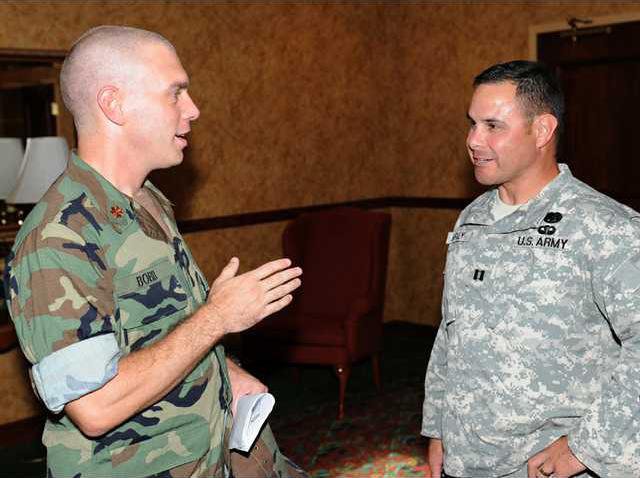Someone has to do it. The U.S. Army's First Brigade of the Third Infantry Division is joining the ranks of those special civilian and military members who prepare the nation for the unthinkable: consequences pertaining to chemical, biological, radiological, nuclear or explosive events on U.S. territory.
Local and federal authorities will deal with the immediate consequences of such an event, but the Department of Defense's Joint Task Force North is ready to put its assets to work if needed.
The Raiders of the 1st Brigade are training for a mission readiness exercise in a couple weeks when they will officially be certified to handle national emergencies.
Many of the 500 people participating in traditional classroom training are members of the 1st BCT, but participants also come from the Navy, the Marine Corps, the Air Force and other Army units. Some are civilian employees and contractors.
On Tuesday, Lt. Cmd. Andrew Bobb was telling a standing-room-only audience about the wide-ranging considerations involved in consequence management following a CBRNE event.
Bobb told the group that trained personnel dealing with human remains were at relatively low risk, "but it scares everybody. If you're not worried about it now, you will be when you see that first body."
One a more pleasant note, Bobb said, "We will evacuate pets. We will decontaminate pets." He said that decision was based on the realization that some people would not leave an endangered area without their pets.
Bobb speculated that terrorists attempting a nuclear attack in the U.S. would attempt to build a weapon similar to the bomb dropped on Hiroshima in World War II. That weapon was basically a gun, which fired a uranium projectile into a uranium target. The combined uranium and energy produce a nuclear chain reaction and the resulting explosion.
Bobb said terrorists were unlikely to have the necessary expertise and materials to successfully produce a working bomb: "We will probably see a fizzle." But that fizzle could still produce a destructive explosion and dangerous radiation.
Classes will continue this week and soldiers will move into the field for exercises. Training experts are already at work preparing Evans Field for the CBRNE exercises.
Local and federal authorities will deal with the immediate consequences of such an event, but the Department of Defense's Joint Task Force North is ready to put its assets to work if needed.
The Raiders of the 1st Brigade are training for a mission readiness exercise in a couple weeks when they will officially be certified to handle national emergencies.
Many of the 500 people participating in traditional classroom training are members of the 1st BCT, but participants also come from the Navy, the Marine Corps, the Air Force and other Army units. Some are civilian employees and contractors.
On Tuesday, Lt. Cmd. Andrew Bobb was telling a standing-room-only audience about the wide-ranging considerations involved in consequence management following a CBRNE event.
Bobb told the group that trained personnel dealing with human remains were at relatively low risk, "but it scares everybody. If you're not worried about it now, you will be when you see that first body."
One a more pleasant note, Bobb said, "We will evacuate pets. We will decontaminate pets." He said that decision was based on the realization that some people would not leave an endangered area without their pets.
Bobb speculated that terrorists attempting a nuclear attack in the U.S. would attempt to build a weapon similar to the bomb dropped on Hiroshima in World War II. That weapon was basically a gun, which fired a uranium projectile into a uranium target. The combined uranium and energy produce a nuclear chain reaction and the resulting explosion.
Bobb said terrorists were unlikely to have the necessary expertise and materials to successfully produce a working bomb: "We will probably see a fizzle." But that fizzle could still produce a destructive explosion and dangerous radiation.
Classes will continue this week and soldiers will move into the field for exercises. Training experts are already at work preparing Evans Field for the CBRNE exercises.




